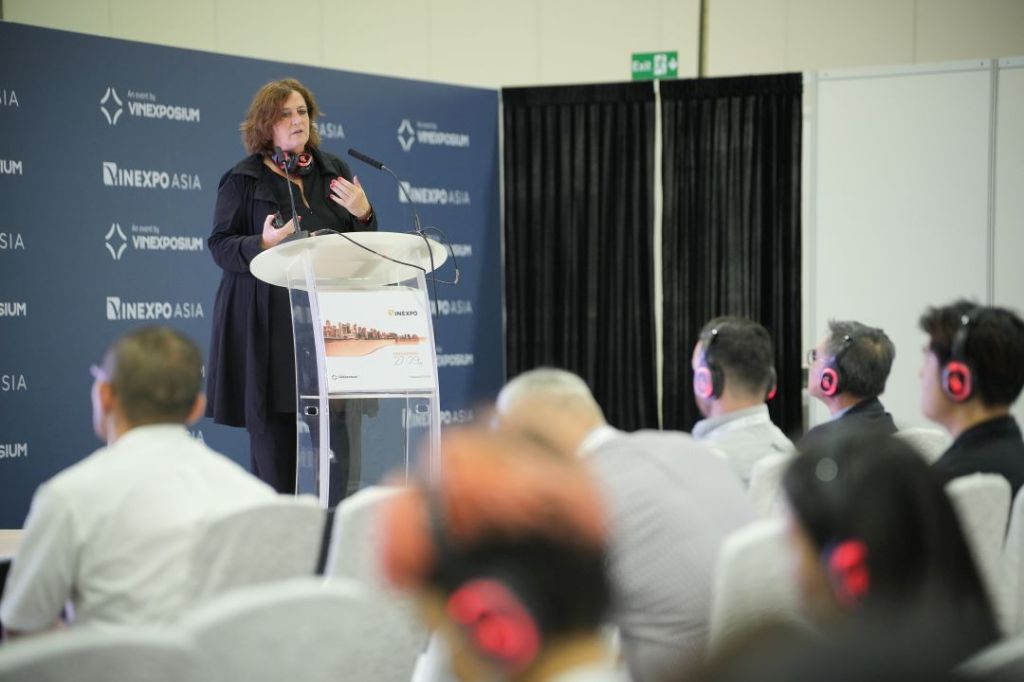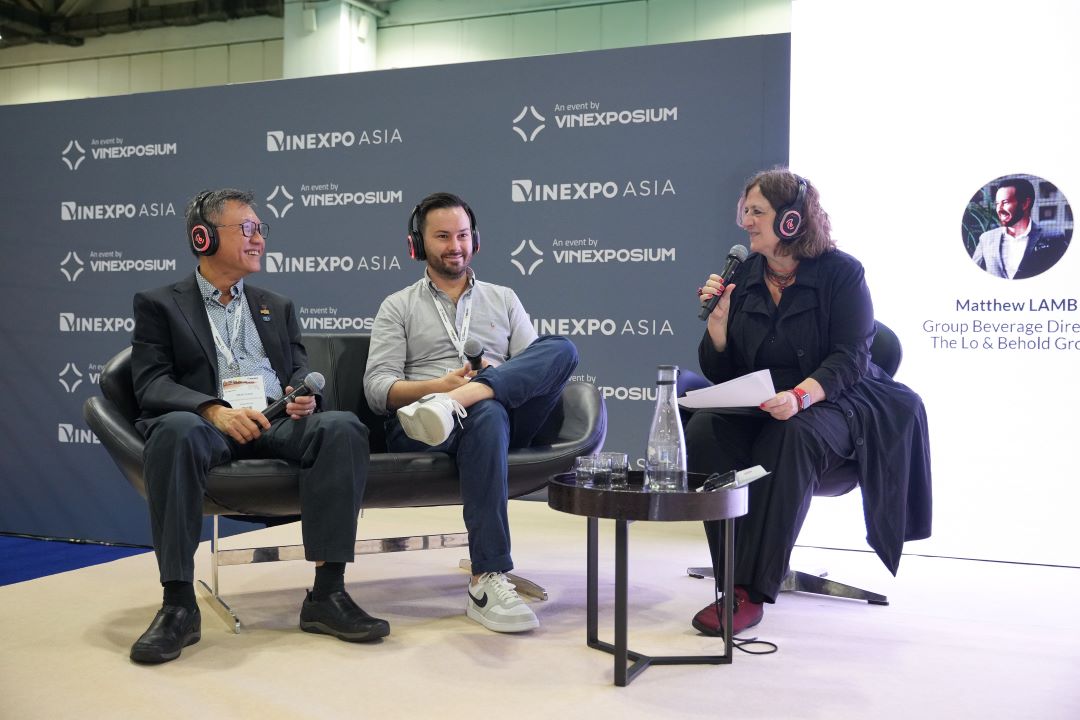Artificial intelligence (AI) is no longer just a buzzword confined to tech sectors – it’s becoming a game-changer in the wine industry. From high-tech robotics to AI-driven marketing tools shaping personalised customer experiences, the future of wine production and sales is being shaped by digital innovation.
Vinexpo Asia 2025 offered a front-row seat to this transformation. Over three days packed with more than 30 masterclasses, panels and tastings, one of which explored how AI is blending science, automation, and creativity to revolutionise the future of wine.
Dr. Anja Zimmer, editor-in-chief of Germany’s Meininger’s International delivered a keynote highlighting the variety of ways that new technologies and artificial intelligence (AI) are impacting the wine and spirits industry.

The session explored technologies at the intersection of taste, sales, and digital innovation.
Zimmer first pointed out the that technological innovation in history has been driven by two key factors – automatization and personalisation – both of which continue to influence the technological choices made in the wine industry from vineyard to cellar, to marketing.
Production made easier
Technological applications on vineyards, included autonomous tractor robots; NASA technology for vine health and sustainability that can detect disease and monitor from above; as well as the recent development of AI glasses to assist with pruning.
Zimmer emphasised the innovation of the glasses in more ways than one.
“It’s quite simple,” she said. “You just take your glasses, connect them with a smartphone, and then you get a picture that shows you exactly where to prune the vine. You can’t do it for the whole vintage, but if you have unskilled workers this can help train them. Finding skilled workers is one of the great things we have to solve. But the glasses tell them where they have to cut.”
Alberto Bermejo, Asia Pacific export director at Felix Solis Avantis – one of the largest wine groups in Spain – also took to the stage and demonstrated a range of automation technologies used to create the company’s self-sufficient cellar.
They invested more than €70m (AU$123.3m) in the facility that is 100 per cent automated and robotic and has the capacity to store 130,000 oak barrels. The 18-storey building has the capacity for filling, emptying and cleaning 90 barrels per hour. It is also 100 per cent sustainable and self-sufficient with 678 solar panels and an ‘A’ energy efficiency score.
Bermejo was clear: “This for us is the future of the winery.”
He noted: “Of course, we will save money, even though we invested a lot it’s for the long term. We also only now have three employees working here so this is also part of the future for us.”
Personalised marketing with AI
In terms of wine marketing the key use of AI technology is for personalisation to improve customer communication and drive sales.
Zimmer was joined on stage by Rick Choo, Founder and Sommelier at The Guild Collective in Singapore and Matthew Lamb, Group Beverage Director for Singapore’s The Lo and Behold Group.
In Choo’s work he said he organises pairing dinners, masterclasses and tasting sessions. He’s found uses for AI in marketing, lectures and creative generation.
Lamb agreed that there are benefits to using AI tools in this way.
“It’s great to free up time, redistribute resources on tasks as well as optimisation. retargeting in marketing campaigns you want to target specific segments of audiences, there’s so much more that can be done now without having to invest any human capital,” he said.
When asked if the AI will benefit the wine industry, Choo said: “Definitely, but I hope the robot will never replace sommeliers like us. You can’t ask a robot to taste the wine and tell you how it feels. No machine can answer that.”
He added: “AI can help consumers make choices, especially for beginners, maybe not on the premium side. But it’s great for production as we saw.”
Both Lamb and Choo addressed concerns of a declining interest in wine from younger generations.
“AI for low engagement consumers or beginners, will be a great stepping stone to get into the wine industry,” said Lamb.
“I think the younger generation do go online, and then they ask questions, and then they see trends. If you use AI to market your products, the younger generation will likely be the first to know of it,” said Choo.

Practical applications
Zimmer offered a number of suggestions for wine businesses to improve personalisation as a part of the consumer experience – the first being on social media, considering how algorithms influence sensory evaluation, product development, and marketing.
AI uses to assist on social media include:
- generating user-targeted content efficiently and at a low cost
- analysing content online that the customer sees
- producing tailored messages
- monitoring conversations and engagement
However, Zimmer also addressed a number of related risks:
- Do not lose your customer by content which is too much AI generated (boring, inauthentic).
- Fact check and verify information. AI can be inaccurate.
- Do not replace AI with the value of human connection.
- Agendas of companies and algorithms can lead to the censoring of content that is misleading or unverified.
The greatest way to avoid these risks, is for businesses to be diverse in reach and investment of money for marketing.
According to research presented by Zimmer from Mckinsey and Co, 75 per cent of consumers said they want it to be easier to navigate purchases in-store and online, while 66 per cent said they want to receive targeted messages that are tailored to their needs.
In response to the data Zimmer said: “I think doing personalisation is no longer nice to have, but a must have. Consumers want to have recommendations. So, where do they get them?”
She gave three key examples of innovation utilised by businesses to assist consumers.
- Tastry – a website that combines chemistry analysis with AI-driven consumer insights to recommend wines to people based on the perceptions of flavour.
- Preferrabli –an app and website that combines a comprehensive database and software for recommendation with a venue or retailers inventory data to make personalised product recommendations.
- Finally, from Germany an AI robot sommelier called WilliWein valued at €50,000 (AU$88,400) was showed in a video demonstration with Philipp Mann, Managing Director of TailorWine.
WilliWein is designed to serve wine, open bottles, pour it, take it to the table, and talk to customers.
Mann asked the robot in a demonstration video, “Can you answer me in English; which wines are trendy right now in Singapore?”
WilliWein responded: “In Singapore, fresh rosé from the Mediterranean is very popular right now, as they cool and refresh perfectly in the tropical climate.”
Interestingly, Choo demonstrated a flaw in the robot technology, pointing out an error that only a sommelier may be able to find.
“When Philip asked the robot, what’s the number one type of wine in Singapore? He said, rosé. I think you will agree with me that rosés are not most popular in Singapore. People here are premium wine and sake drinkers that don’t have as much of a taste for rosé,” he said.
Low and Behold’s Lamb added he is not concerned that AI technology will replace human interaction in the experience of wine.
“We work in the people industry. We just have different mediums that we communicate through. whether it’s in production, dealing with a finished product, in restaurant. It’s the old saying the greatest bottle of wine is a bottle of shared. You don’t want to be sitting down and sharing it with Mr. iRobot…yet”.
The experts concluded that embracing innovation in AI means understanding where technology can add real value and mitigating risks.

